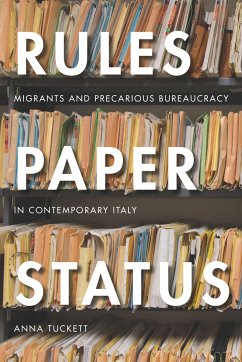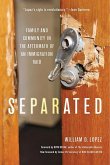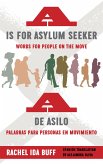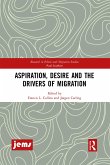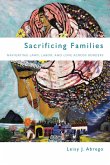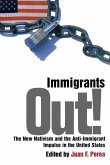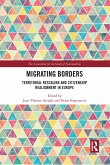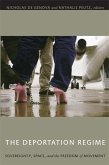- Broschiertes Buch
- Merkliste
- Auf die Merkliste
- Bewerten Bewerten
- Teilen
- Produkt teilen
- Produkterinnerung
- Produkterinnerung
Anna Tuckett is Research Fellow in the Department of Anthropology at the London School of Economics and Political Science.
Andere Kunden interessierten sich auch für
![Separated Separated]() William D LopezSeparated27,99 €
William D LopezSeparated27,99 €![A is for Asylum Seeker: Words for People on the Move / A de Asilo: Palabras Para Personas En Movimiento A is for Asylum Seeker: Words for People on the Move / A de Asilo: Palabras Para Personas En Movimiento]() Rachel Ida BuffA is for Asylum Seeker: Words for People on the Move / A de Asilo: Palabras Para Personas En Movimiento19,99 €
Rachel Ida BuffA is for Asylum Seeker: Words for People on the Move / A de Asilo: Palabras Para Personas En Movimiento19,99 €![Aspiration, Desire and the Drivers of Migration Aspiration, Desire and the Drivers of Migration]() Aspiration, Desire and the Drivers of Migration64,99 €
Aspiration, Desire and the Drivers of Migration64,99 €![Sacrificing Families Sacrificing Families]() Leisy J AbregoSacrificing Families26,99 €
Leisy J AbregoSacrificing Families26,99 €![Immigrants Out! Immigrants Out!]() Immigrants Out!39,99 €
Immigrants Out!39,99 €![Migrating Borders Migrating Borders]() Migrating Borders64,99 €
Migrating Borders64,99 €![The Deportation Regime The Deportation Regime]() The Deportation Regime40,99 €
The Deportation Regime40,99 €-
-
-
Anna Tuckett is Research Fellow in the Department of Anthropology at the London School of Economics and Political Science.
Hinweis: Dieser Artikel kann nur an eine deutsche Lieferadresse ausgeliefert werden.
Hinweis: Dieser Artikel kann nur an eine deutsche Lieferadresse ausgeliefert werden.
Produktdetails
- Produktdetails
- Verlag: Stanford University Press
- Seitenzahl: 192
- Erscheinungstermin: 26. Juni 2018
- Englisch
- Abmessung: 228mm x 151mm x 15mm
- Gewicht: 307g
- ISBN-13: 9781503606494
- ISBN-10: 150360649X
- Artikelnr.: 49389650
- Herstellerkennzeichnung
- Libri GmbH
- Europaallee 1
- 36244 Bad Hersfeld
- 06621 890
- Verlag: Stanford University Press
- Seitenzahl: 192
- Erscheinungstermin: 26. Juni 2018
- Englisch
- Abmessung: 228mm x 151mm x 15mm
- Gewicht: 307g
- ISBN-13: 9781503606494
- ISBN-10: 150360649X
- Artikelnr.: 49389650
- Herstellerkennzeichnung
- Libri GmbH
- Europaallee 1
- 36244 Bad Hersfeld
- 06621 890
Anna Tuckett is Research Fellow in the Department of Anthropology at the London School of Economics and Political Science.
Contents and Abstracts
Introduction
chapter abstract
This chapter examines the historical trajectory of Italian immigration law
and the political and economic context from which it emerges. In general
migrants have not been welcomed into Italian society, but low birth rates
and a high aging population make their presence crucial. Italian
immigration law, which is a curious mixture between harsh and exclusionary
policies and frequent large-scale legalizations, embodies this ambiguous
attitude towards migrants. This chapter argues that equal attention must be
given to processes relating to "legalization" as to those relating to
"illegalization" when considering migrants' experiences of "legal" and
"illegal" statuses. While other studies on experiences of immigration law
tend to focus on migrants' experiences of uncertainty, this focus on the
bureaucratic and documentary practices of immigration provides insights on
alternative affective dimensions of immigration law and its material
artefacts.
1The Center
chapter abstract
This chapter introduces the book's central fieldsite: a trade union
affiliated migrant advice center which provides support and assistance to
migrants in their completion of application forms, as well as navigation of
the immigration bureaucracy more generally. Trade unions have a central
function in the Italian welfare state, and the center's role in completing
migrants' application forms is closely connected to this. Although
affiliated to the trade union, in the eyes of its visitors, and in
practice, the center's role is often blurred with that of the Questura
(Immigration Office) and the state in general. Because the center acts as a
mediator between migrants and the Questura, the assistance which clients
received could determine application outcomes. Not all staff members were
equally able or interested in migration matters, however, and the quality
of assistance they provided was highly variable.
2Working the Gap: Migrants' Navigation of Immigration Bureaucracy
chapter abstract
Through gripping case studies, this chapter illustrates how everyday
experiences with Italian immigration bureaucracy are characterized by
uncertainty, arbitrariness, and frustration. By closely examining migrants'
bureaucratic encounters, however, the chapter reveals that the
bureaucracy's arbitrary and uncertain nature also makes it flexible and
relatively easy to manipulate. By engaging in effective strategies of
navigation, migrants are able to manipulate the law's loopholes and aid the
acceptance of applications. Tracing migrants' strategies, this chapter
argues that "formal" and "informal" spheres are interdependent and
symbiotic: migrants, brokers, advisers, and officials all must engage in
"informal" and extra-legal practices in order to successfully navigate the
immigration bureaucracy.
3The Rules of Rule-Bending
chapter abstract
This chapter argues that rule bending is revealing of broader attitudes to
the state and bureaucracy in Italy which, through their bureaucratic
encounters, migrants also come to hold. Bureaucratic engagements are thus
forms of citizen-making. Socially acceptable rule-breaking, however, is
accompanied by strict compliance with proceduralism in relation to
paperwork. Successfully navigating the immigration bureaucracy requires
expertise in the management of documents: paper trails must seem authentic
even if false. Yet, given the documented nature of migrants' lives,
rule-bending in one application can potentially create problems in others,
meaning that even skillful rule-bending can result in high risks for
migrants, such as the loss of legal status or foreclosing the attainment of
citizenship. There thus exists a mismatch between a migrant's social
knowledge - which is required to navigate the bureaucracy - and
exclusionary citizenship laws that make this embeddedness precarious.
4Becoming an Immigration Adviser: Self-Fashioning through Bureaucratic
Practice
chapter abstract
This chapter focuses on the role of community brokers - informal
immigration advisers with migrant backgrounds - and shows how they style
themselves as bureaucratic experts. Doing so enables these brokers to
develop new subjectivities and fashion themselves in affective terms.
Becoming advisers enables them a degree of professionalism, helps them gain
standing in their community, satisfies charitable impulses, and places them
center stage in the fight for social justice. Crucially, the role of a
community broker offers possibilities for gaining social status that are
generally not otherwise available to migrants in Italy.
5Disjuncture in the Documentation Regime: The Second Generation's Challenge
to Citizenship Law
chapter abstract
Reflecting on the second generation's experiences of immigration
bureaucracy, this chapter considers the contradictory and divergent affects
of immigration law encounters. If dealings with the immigration bureaucracy
produce opportunities for first-generation migrants and their advisers, for
the second-generation they create upset and disjuncture. This generation is
the most vulnerable group in terms of immigration policies as its members
may suddenly find themselves as "undocumented immigrants" after turning 18,
due to Italy's jus sanguinis nationality policy. Their sense of ease and
integration in Italian society make them strangers to the immigration
bureaucracy which - due to restrictive immigration and citizenship laws -
they are nonetheless subject. The disjuncture made apparent through the
second generation's subjection to immigration law highlights the profound
injustices and inequalities that such laws create for all migrants.
6Stepping-Stone Destinations: Migration and Disappointment
chapter abstract
This chapter explores migrants' feelings of disappointment about their
migration trajectory in Italy and their desire to leave the country. The
disappointment of those who aspire to migrate but ultimately never leave
their homelands has been extensively discussed in migration studies
literature. The chapter places the focus on those who have migrated but who
still feel as though they have failed due to their lack of onward mobility
from Italy. Focusing on the feelings of disappointment and personal failure
experienced by those who have already migrated, it highlights the
differentiated inclusion of migrants into the global marketplace. The
desire to leave Italy, whether imagined or acted upon, shows how the
mobility enabled by neoliberal globalization reproduces hierarchies within
the EU. By viewing Italy as a mere stepping stone in a longer trajectory,
migrants - both those who leave and those who remain - conceptualize the
country as an inferior destination.
Conclusion:
chapter abstract
Drawing the preceding chapters together, this conclusion argues that the
"border spectacle" (De Genova 2002) produces a lopsided view of migration
by obscuring how immigration policies relate to broader political and
economic processes of contemporary migration and globalization. Situating
migrants' navigation of the documentation regime in relation to these
process, the chapter argues that migrants' maneuvering provides them with
only meagre benefits, while employers, lawyers, policy makers, and other
stakeholders within the immigration nexus reap the rewards. The final
section of the conclusion reflects on what policies could improve the
current situation in light of the problems identified.
Introduction
chapter abstract
This chapter examines the historical trajectory of Italian immigration law
and the political and economic context from which it emerges. In general
migrants have not been welcomed into Italian society, but low birth rates
and a high aging population make their presence crucial. Italian
immigration law, which is a curious mixture between harsh and exclusionary
policies and frequent large-scale legalizations, embodies this ambiguous
attitude towards migrants. This chapter argues that equal attention must be
given to processes relating to "legalization" as to those relating to
"illegalization" when considering migrants' experiences of "legal" and
"illegal" statuses. While other studies on experiences of immigration law
tend to focus on migrants' experiences of uncertainty, this focus on the
bureaucratic and documentary practices of immigration provides insights on
alternative affective dimensions of immigration law and its material
artefacts.
1The Center
chapter abstract
This chapter introduces the book's central fieldsite: a trade union
affiliated migrant advice center which provides support and assistance to
migrants in their completion of application forms, as well as navigation of
the immigration bureaucracy more generally. Trade unions have a central
function in the Italian welfare state, and the center's role in completing
migrants' application forms is closely connected to this. Although
affiliated to the trade union, in the eyes of its visitors, and in
practice, the center's role is often blurred with that of the Questura
(Immigration Office) and the state in general. Because the center acts as a
mediator between migrants and the Questura, the assistance which clients
received could determine application outcomes. Not all staff members were
equally able or interested in migration matters, however, and the quality
of assistance they provided was highly variable.
2Working the Gap: Migrants' Navigation of Immigration Bureaucracy
chapter abstract
Through gripping case studies, this chapter illustrates how everyday
experiences with Italian immigration bureaucracy are characterized by
uncertainty, arbitrariness, and frustration. By closely examining migrants'
bureaucratic encounters, however, the chapter reveals that the
bureaucracy's arbitrary and uncertain nature also makes it flexible and
relatively easy to manipulate. By engaging in effective strategies of
navigation, migrants are able to manipulate the law's loopholes and aid the
acceptance of applications. Tracing migrants' strategies, this chapter
argues that "formal" and "informal" spheres are interdependent and
symbiotic: migrants, brokers, advisers, and officials all must engage in
"informal" and extra-legal practices in order to successfully navigate the
immigration bureaucracy.
3The Rules of Rule-Bending
chapter abstract
This chapter argues that rule bending is revealing of broader attitudes to
the state and bureaucracy in Italy which, through their bureaucratic
encounters, migrants also come to hold. Bureaucratic engagements are thus
forms of citizen-making. Socially acceptable rule-breaking, however, is
accompanied by strict compliance with proceduralism in relation to
paperwork. Successfully navigating the immigration bureaucracy requires
expertise in the management of documents: paper trails must seem authentic
even if false. Yet, given the documented nature of migrants' lives,
rule-bending in one application can potentially create problems in others,
meaning that even skillful rule-bending can result in high risks for
migrants, such as the loss of legal status or foreclosing the attainment of
citizenship. There thus exists a mismatch between a migrant's social
knowledge - which is required to navigate the bureaucracy - and
exclusionary citizenship laws that make this embeddedness precarious.
4Becoming an Immigration Adviser: Self-Fashioning through Bureaucratic
Practice
chapter abstract
This chapter focuses on the role of community brokers - informal
immigration advisers with migrant backgrounds - and shows how they style
themselves as bureaucratic experts. Doing so enables these brokers to
develop new subjectivities and fashion themselves in affective terms.
Becoming advisers enables them a degree of professionalism, helps them gain
standing in their community, satisfies charitable impulses, and places them
center stage in the fight for social justice. Crucially, the role of a
community broker offers possibilities for gaining social status that are
generally not otherwise available to migrants in Italy.
5Disjuncture in the Documentation Regime: The Second Generation's Challenge
to Citizenship Law
chapter abstract
Reflecting on the second generation's experiences of immigration
bureaucracy, this chapter considers the contradictory and divergent affects
of immigration law encounters. If dealings with the immigration bureaucracy
produce opportunities for first-generation migrants and their advisers, for
the second-generation they create upset and disjuncture. This generation is
the most vulnerable group in terms of immigration policies as its members
may suddenly find themselves as "undocumented immigrants" after turning 18,
due to Italy's jus sanguinis nationality policy. Their sense of ease and
integration in Italian society make them strangers to the immigration
bureaucracy which - due to restrictive immigration and citizenship laws -
they are nonetheless subject. The disjuncture made apparent through the
second generation's subjection to immigration law highlights the profound
injustices and inequalities that such laws create for all migrants.
6Stepping-Stone Destinations: Migration and Disappointment
chapter abstract
This chapter explores migrants' feelings of disappointment about their
migration trajectory in Italy and their desire to leave the country. The
disappointment of those who aspire to migrate but ultimately never leave
their homelands has been extensively discussed in migration studies
literature. The chapter places the focus on those who have migrated but who
still feel as though they have failed due to their lack of onward mobility
from Italy. Focusing on the feelings of disappointment and personal failure
experienced by those who have already migrated, it highlights the
differentiated inclusion of migrants into the global marketplace. The
desire to leave Italy, whether imagined or acted upon, shows how the
mobility enabled by neoliberal globalization reproduces hierarchies within
the EU. By viewing Italy as a mere stepping stone in a longer trajectory,
migrants - both those who leave and those who remain - conceptualize the
country as an inferior destination.
Conclusion:
chapter abstract
Drawing the preceding chapters together, this conclusion argues that the
"border spectacle" (De Genova 2002) produces a lopsided view of migration
by obscuring how immigration policies relate to broader political and
economic processes of contemporary migration and globalization. Situating
migrants' navigation of the documentation regime in relation to these
process, the chapter argues that migrants' maneuvering provides them with
only meagre benefits, while employers, lawyers, policy makers, and other
stakeholders within the immigration nexus reap the rewards. The final
section of the conclusion reflects on what policies could improve the
current situation in light of the problems identified.
Contents and Abstracts
Introduction
chapter abstract
This chapter examines the historical trajectory of Italian immigration law
and the political and economic context from which it emerges. In general
migrants have not been welcomed into Italian society, but low birth rates
and a high aging population make their presence crucial. Italian
immigration law, which is a curious mixture between harsh and exclusionary
policies and frequent large-scale legalizations, embodies this ambiguous
attitude towards migrants. This chapter argues that equal attention must be
given to processes relating to "legalization" as to those relating to
"illegalization" when considering migrants' experiences of "legal" and
"illegal" statuses. While other studies on experiences of immigration law
tend to focus on migrants' experiences of uncertainty, this focus on the
bureaucratic and documentary practices of immigration provides insights on
alternative affective dimensions of immigration law and its material
artefacts.
1The Center
chapter abstract
This chapter introduces the book's central fieldsite: a trade union
affiliated migrant advice center which provides support and assistance to
migrants in their completion of application forms, as well as navigation of
the immigration bureaucracy more generally. Trade unions have a central
function in the Italian welfare state, and the center's role in completing
migrants' application forms is closely connected to this. Although
affiliated to the trade union, in the eyes of its visitors, and in
practice, the center's role is often blurred with that of the Questura
(Immigration Office) and the state in general. Because the center acts as a
mediator between migrants and the Questura, the assistance which clients
received could determine application outcomes. Not all staff members were
equally able or interested in migration matters, however, and the quality
of assistance they provided was highly variable.
2Working the Gap: Migrants' Navigation of Immigration Bureaucracy
chapter abstract
Through gripping case studies, this chapter illustrates how everyday
experiences with Italian immigration bureaucracy are characterized by
uncertainty, arbitrariness, and frustration. By closely examining migrants'
bureaucratic encounters, however, the chapter reveals that the
bureaucracy's arbitrary and uncertain nature also makes it flexible and
relatively easy to manipulate. By engaging in effective strategies of
navigation, migrants are able to manipulate the law's loopholes and aid the
acceptance of applications. Tracing migrants' strategies, this chapter
argues that "formal" and "informal" spheres are interdependent and
symbiotic: migrants, brokers, advisers, and officials all must engage in
"informal" and extra-legal practices in order to successfully navigate the
immigration bureaucracy.
3The Rules of Rule-Bending
chapter abstract
This chapter argues that rule bending is revealing of broader attitudes to
the state and bureaucracy in Italy which, through their bureaucratic
encounters, migrants also come to hold. Bureaucratic engagements are thus
forms of citizen-making. Socially acceptable rule-breaking, however, is
accompanied by strict compliance with proceduralism in relation to
paperwork. Successfully navigating the immigration bureaucracy requires
expertise in the management of documents: paper trails must seem authentic
even if false. Yet, given the documented nature of migrants' lives,
rule-bending in one application can potentially create problems in others,
meaning that even skillful rule-bending can result in high risks for
migrants, such as the loss of legal status or foreclosing the attainment of
citizenship. There thus exists a mismatch between a migrant's social
knowledge - which is required to navigate the bureaucracy - and
exclusionary citizenship laws that make this embeddedness precarious.
4Becoming an Immigration Adviser: Self-Fashioning through Bureaucratic
Practice
chapter abstract
This chapter focuses on the role of community brokers - informal
immigration advisers with migrant backgrounds - and shows how they style
themselves as bureaucratic experts. Doing so enables these brokers to
develop new subjectivities and fashion themselves in affective terms.
Becoming advisers enables them a degree of professionalism, helps them gain
standing in their community, satisfies charitable impulses, and places them
center stage in the fight for social justice. Crucially, the role of a
community broker offers possibilities for gaining social status that are
generally not otherwise available to migrants in Italy.
5Disjuncture in the Documentation Regime: The Second Generation's Challenge
to Citizenship Law
chapter abstract
Reflecting on the second generation's experiences of immigration
bureaucracy, this chapter considers the contradictory and divergent affects
of immigration law encounters. If dealings with the immigration bureaucracy
produce opportunities for first-generation migrants and their advisers, for
the second-generation they create upset and disjuncture. This generation is
the most vulnerable group in terms of immigration policies as its members
may suddenly find themselves as "undocumented immigrants" after turning 18,
due to Italy's jus sanguinis nationality policy. Their sense of ease and
integration in Italian society make them strangers to the immigration
bureaucracy which - due to restrictive immigration and citizenship laws -
they are nonetheless subject. The disjuncture made apparent through the
second generation's subjection to immigration law highlights the profound
injustices and inequalities that such laws create for all migrants.
6Stepping-Stone Destinations: Migration and Disappointment
chapter abstract
This chapter explores migrants' feelings of disappointment about their
migration trajectory in Italy and their desire to leave the country. The
disappointment of those who aspire to migrate but ultimately never leave
their homelands has been extensively discussed in migration studies
literature. The chapter places the focus on those who have migrated but who
still feel as though they have failed due to their lack of onward mobility
from Italy. Focusing on the feelings of disappointment and personal failure
experienced by those who have already migrated, it highlights the
differentiated inclusion of migrants into the global marketplace. The
desire to leave Italy, whether imagined or acted upon, shows how the
mobility enabled by neoliberal globalization reproduces hierarchies within
the EU. By viewing Italy as a mere stepping stone in a longer trajectory,
migrants - both those who leave and those who remain - conceptualize the
country as an inferior destination.
Conclusion:
chapter abstract
Drawing the preceding chapters together, this conclusion argues that the
"border spectacle" (De Genova 2002) produces a lopsided view of migration
by obscuring how immigration policies relate to broader political and
economic processes of contemporary migration and globalization. Situating
migrants' navigation of the documentation regime in relation to these
process, the chapter argues that migrants' maneuvering provides them with
only meagre benefits, while employers, lawyers, policy makers, and other
stakeholders within the immigration nexus reap the rewards. The final
section of the conclusion reflects on what policies could improve the
current situation in light of the problems identified.
Introduction
chapter abstract
This chapter examines the historical trajectory of Italian immigration law
and the political and economic context from which it emerges. In general
migrants have not been welcomed into Italian society, but low birth rates
and a high aging population make their presence crucial. Italian
immigration law, which is a curious mixture between harsh and exclusionary
policies and frequent large-scale legalizations, embodies this ambiguous
attitude towards migrants. This chapter argues that equal attention must be
given to processes relating to "legalization" as to those relating to
"illegalization" when considering migrants' experiences of "legal" and
"illegal" statuses. While other studies on experiences of immigration law
tend to focus on migrants' experiences of uncertainty, this focus on the
bureaucratic and documentary practices of immigration provides insights on
alternative affective dimensions of immigration law and its material
artefacts.
1The Center
chapter abstract
This chapter introduces the book's central fieldsite: a trade union
affiliated migrant advice center which provides support and assistance to
migrants in their completion of application forms, as well as navigation of
the immigration bureaucracy more generally. Trade unions have a central
function in the Italian welfare state, and the center's role in completing
migrants' application forms is closely connected to this. Although
affiliated to the trade union, in the eyes of its visitors, and in
practice, the center's role is often blurred with that of the Questura
(Immigration Office) and the state in general. Because the center acts as a
mediator between migrants and the Questura, the assistance which clients
received could determine application outcomes. Not all staff members were
equally able or interested in migration matters, however, and the quality
of assistance they provided was highly variable.
2Working the Gap: Migrants' Navigation of Immigration Bureaucracy
chapter abstract
Through gripping case studies, this chapter illustrates how everyday
experiences with Italian immigration bureaucracy are characterized by
uncertainty, arbitrariness, and frustration. By closely examining migrants'
bureaucratic encounters, however, the chapter reveals that the
bureaucracy's arbitrary and uncertain nature also makes it flexible and
relatively easy to manipulate. By engaging in effective strategies of
navigation, migrants are able to manipulate the law's loopholes and aid the
acceptance of applications. Tracing migrants' strategies, this chapter
argues that "formal" and "informal" spheres are interdependent and
symbiotic: migrants, brokers, advisers, and officials all must engage in
"informal" and extra-legal practices in order to successfully navigate the
immigration bureaucracy.
3The Rules of Rule-Bending
chapter abstract
This chapter argues that rule bending is revealing of broader attitudes to
the state and bureaucracy in Italy which, through their bureaucratic
encounters, migrants also come to hold. Bureaucratic engagements are thus
forms of citizen-making. Socially acceptable rule-breaking, however, is
accompanied by strict compliance with proceduralism in relation to
paperwork. Successfully navigating the immigration bureaucracy requires
expertise in the management of documents: paper trails must seem authentic
even if false. Yet, given the documented nature of migrants' lives,
rule-bending in one application can potentially create problems in others,
meaning that even skillful rule-bending can result in high risks for
migrants, such as the loss of legal status or foreclosing the attainment of
citizenship. There thus exists a mismatch between a migrant's social
knowledge - which is required to navigate the bureaucracy - and
exclusionary citizenship laws that make this embeddedness precarious.
4Becoming an Immigration Adviser: Self-Fashioning through Bureaucratic
Practice
chapter abstract
This chapter focuses on the role of community brokers - informal
immigration advisers with migrant backgrounds - and shows how they style
themselves as bureaucratic experts. Doing so enables these brokers to
develop new subjectivities and fashion themselves in affective terms.
Becoming advisers enables them a degree of professionalism, helps them gain
standing in their community, satisfies charitable impulses, and places them
center stage in the fight for social justice. Crucially, the role of a
community broker offers possibilities for gaining social status that are
generally not otherwise available to migrants in Italy.
5Disjuncture in the Documentation Regime: The Second Generation's Challenge
to Citizenship Law
chapter abstract
Reflecting on the second generation's experiences of immigration
bureaucracy, this chapter considers the contradictory and divergent affects
of immigration law encounters. If dealings with the immigration bureaucracy
produce opportunities for first-generation migrants and their advisers, for
the second-generation they create upset and disjuncture. This generation is
the most vulnerable group in terms of immigration policies as its members
may suddenly find themselves as "undocumented immigrants" after turning 18,
due to Italy's jus sanguinis nationality policy. Their sense of ease and
integration in Italian society make them strangers to the immigration
bureaucracy which - due to restrictive immigration and citizenship laws -
they are nonetheless subject. The disjuncture made apparent through the
second generation's subjection to immigration law highlights the profound
injustices and inequalities that such laws create for all migrants.
6Stepping-Stone Destinations: Migration and Disappointment
chapter abstract
This chapter explores migrants' feelings of disappointment about their
migration trajectory in Italy and their desire to leave the country. The
disappointment of those who aspire to migrate but ultimately never leave
their homelands has been extensively discussed in migration studies
literature. The chapter places the focus on those who have migrated but who
still feel as though they have failed due to their lack of onward mobility
from Italy. Focusing on the feelings of disappointment and personal failure
experienced by those who have already migrated, it highlights the
differentiated inclusion of migrants into the global marketplace. The
desire to leave Italy, whether imagined or acted upon, shows how the
mobility enabled by neoliberal globalization reproduces hierarchies within
the EU. By viewing Italy as a mere stepping stone in a longer trajectory,
migrants - both those who leave and those who remain - conceptualize the
country as an inferior destination.
Conclusion:
chapter abstract
Drawing the preceding chapters together, this conclusion argues that the
"border spectacle" (De Genova 2002) produces a lopsided view of migration
by obscuring how immigration policies relate to broader political and
economic processes of contemporary migration and globalization. Situating
migrants' navigation of the documentation regime in relation to these
process, the chapter argues that migrants' maneuvering provides them with
only meagre benefits, while employers, lawyers, policy makers, and other
stakeholders within the immigration nexus reap the rewards. The final
section of the conclusion reflects on what policies could improve the
current situation in light of the problems identified.

